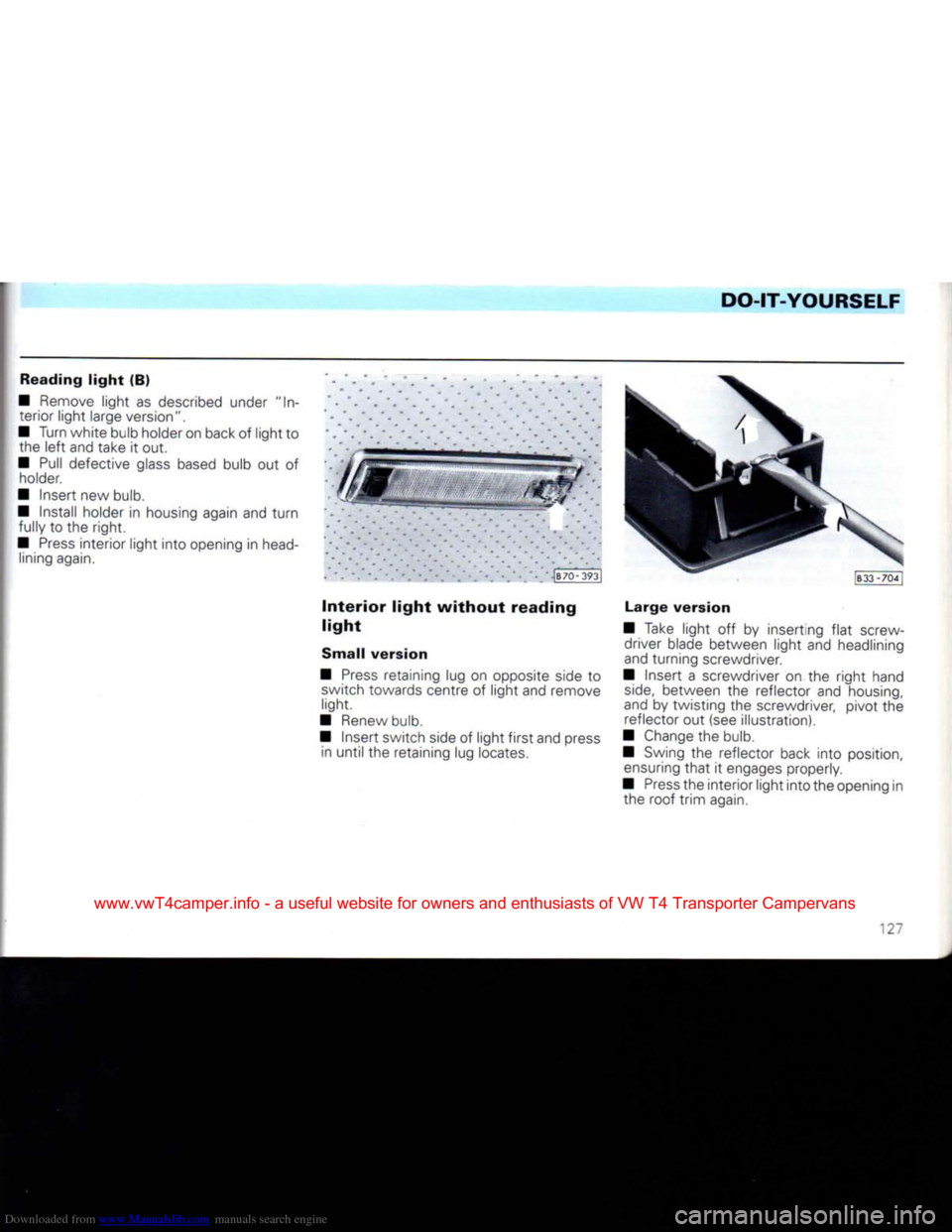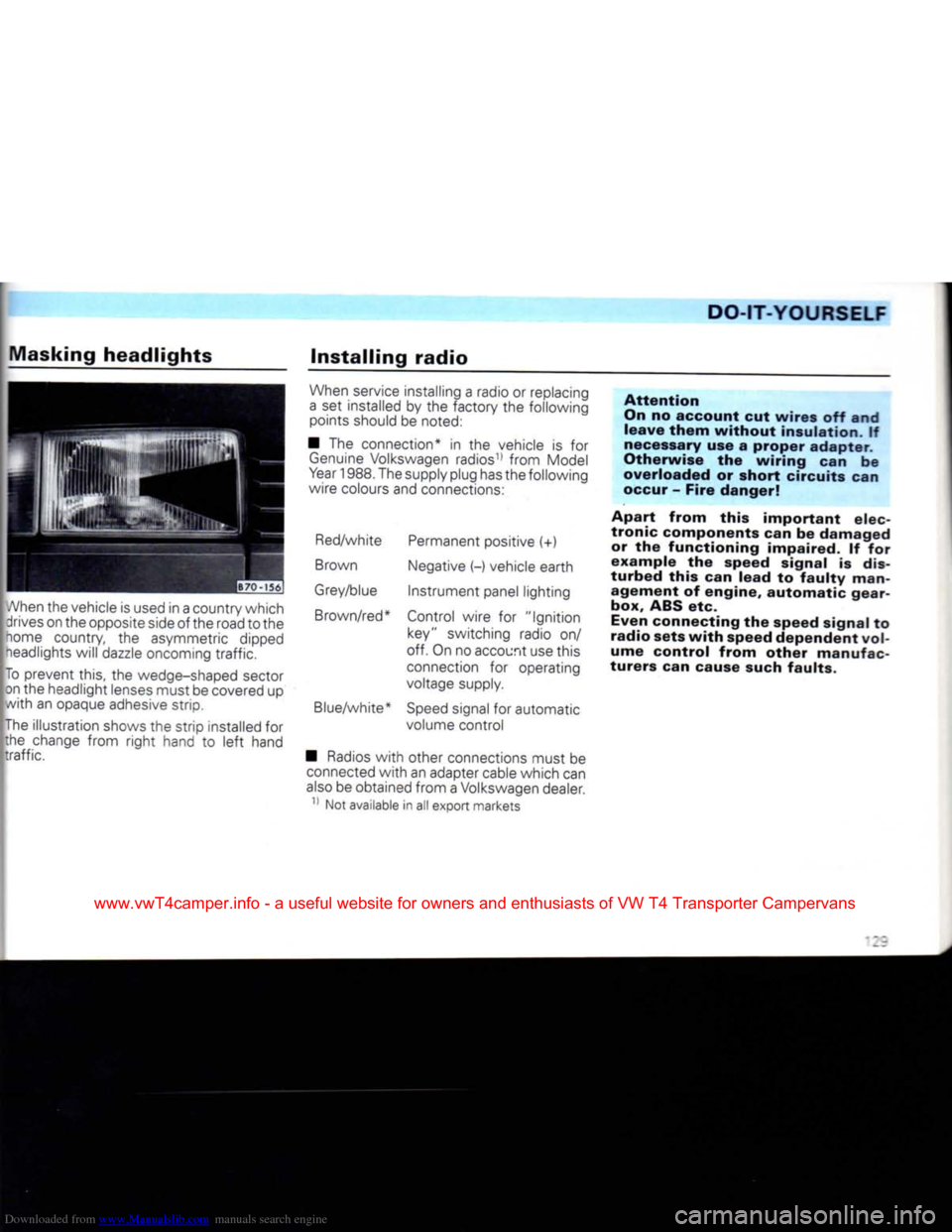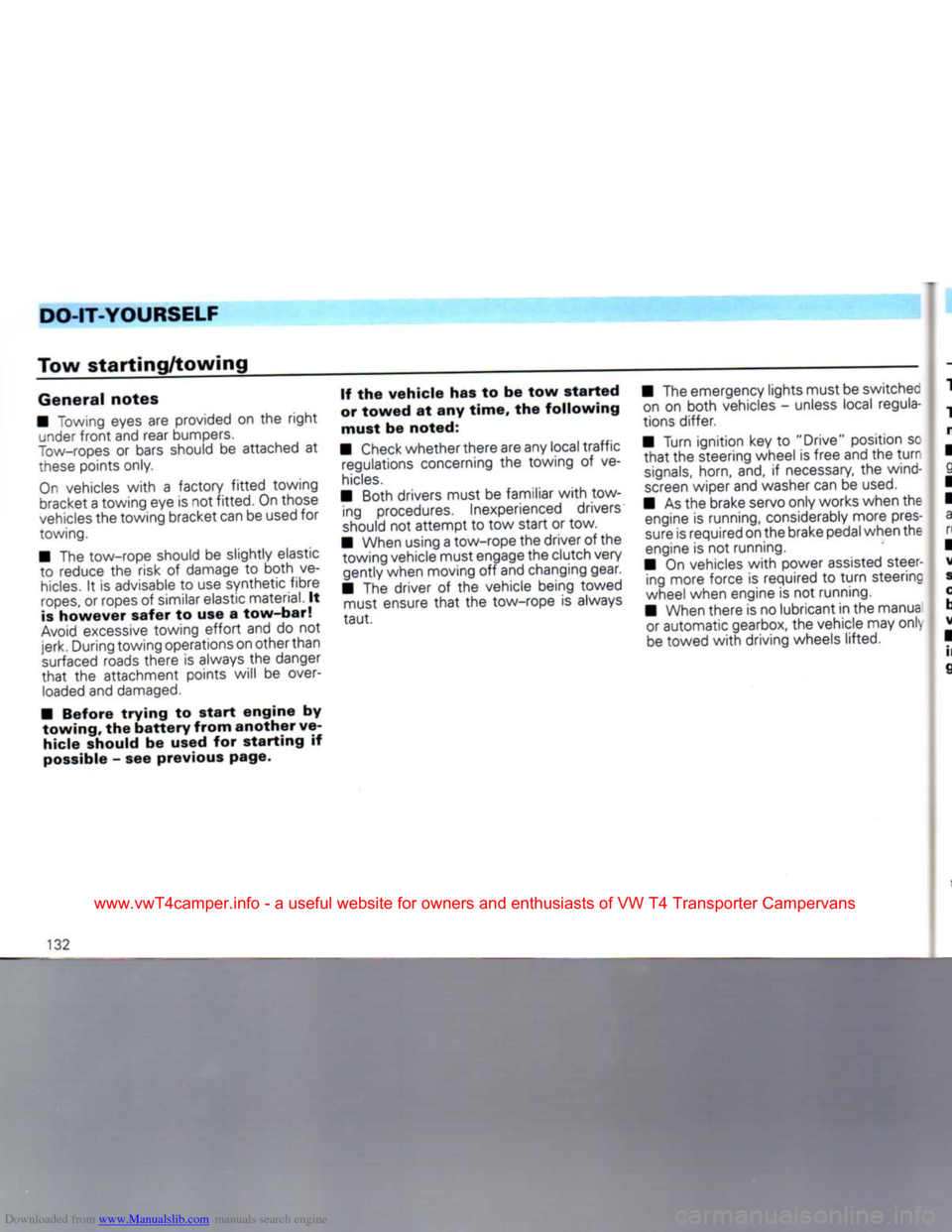1992 VOLKSWAGEN TRANSPORTER light
[x] Cancel search: lightPage 125 of 164

Downloaded from www.Manualslib.com manuals search engine
DO-IT-YOURSELF
Fuse
layout
<*'om
left
to
right)
No.
Component
A11
' - Dipped beam
left,
headlight range control
left
10
I- Dipped beam
right,
headlight range control
right
10
3-
Instrument
and number plate lighting 10
--
Rear
wiper, seat heating 15
5-
Windscreen wiper,
windscreen and rear window
washer/elec.
heated
washer
jets 15
5-
Blower, air conditioner 30
/- Tail and side
light
right,
engine compartment
light
10
3-
Tail and side
light
left
10
9-
Rear
window heating, mirror heating 20
10-
Fog lights, rear fog
light
15
II- High beam
left,
high beam
warning lamp 10
12-
High beam
right
10
13-
Horn, radiator fan (run-on) 10
1 Ampere No.
Component
A
14-
Reversing lights, electric outside mirrors, sliding/tilting
roof,
shift pattern auto, gearbox,
cruise
control system
(cancel contacts on the brake
and clutch pedal) 10
15-
Engine electronics 10
16-
Warning lamps,
dash
panel insert,
glove box
light
15
17-
Turn signals 10
18-
Electric fuel pump,
Lambda
probe 20
19-
Radiator fan, air conditioner 30
20-
Brake lights 10
21-
Interior
and luggage compartment lights, make-up mirror
light,
clock,
radio,
central locking 15
22-
Cigarette lighter 10
Additional
fuses
(in separate holders)
• above the relays A11
Fuse
for electric windows 20
• In the engine compartment on the bulk
head
above the brake servo:
Glow
plugs21 50
• Under the driver's seat
Fuse
for additional water heater 10
Fuse
for heater blower .30
Fuse
for water heater
glow plug 20
Fuse
for auxiliary heater3' 25
Fuse colour code:
Red:
10 Ampere
Blue:
15 Ampere
Yellow:
20 Ampere
Green:
30 Ampere
21 This fuse should only be renewed by
a
Volks
wagen dealer.
31 On vehicles
with
swivelling seats this fuse
can
be found in the side
trim
behind the
driver's seat.
123
www.vwT4camper.info - a useful website for owners and enthusiasts of VW T4 Transporter Campervans
Page 126 of 164

Downloaded from www.Manualslib.com manuals search engine
DO-IT-YOURSELF
Changing bulbs
Before
starting to replace a bulb, switch off
the light concerned.
Do
not touch the glass part of the new bulb
with
bare fingers because the finger marks
left
on the glass evaporate when the bulb
becomes
hot, the vapour settles on the re
flector and dims it.
Always
use the same type of bulb. The
des
ignation is marked on the base of the bulb
or on the
glass.
It is advisable to always a carry a box of
spare
bulbs in the vehicle. These can be ob
tained from Volkswagen dealers. It should contain at least the following bulbs which
are essential for traffic safety:
12 V 60/55 W Headlight (H4)
12V21W
Turn signal
12V21/5W
Brake
and tail light
12 V4W
Side
light
12V5W
Glass
base
Number
plate light
Headlights
The
headlight bulbs can be reached through
the opened bonnet.
• Pull off the connector.
• Pull cap off.
•
Squeeze
the spring clip of the bulb holder together and pull down.
• Take the bulb out and insert the new bulb
so
that
the locating lug on the bulb plate en
gages
the recess in the reflector. The centre
of the three terminals on the bulb base is
then at the top.
• Fold the spring clip over bulb
base.
Squeeze
the clip together and engage it in
the retaining lugs.
•
Press
the cap back on.
• Attach the connector.
• Have the headlight beam alignment
checked.
Side
light
bulb
The
side light bulbs are located in the head light reflectors.
• Turn the bulb holder fully to the
left
and take it out of the reflector.
•
Press
the defective bulb into the holder,
turn
it to
left
and take it out.
• Insert the new bulb.
• Insert the bulb holder in the reflector and
turn
the holder fully to the
right.
124
www.vwT4camper.info - a useful website for owners and enthusiasts of VW T4 Transporter Campervans
Page 127 of 164

Downloaded from www.Manualslib.com manuals search engine
DO-IT-YOURSELF
Front
turn
signals
To
change a bulb the
turn
signal housing must be taken out to the
front.
•
Insert
the
flat
blade of a screwdriver be tween headlight and
turn
signal
with
bonnet
open.
This presses the securing tabs which hold the
turn
signal housing to the
side.
• Swing screwdriver to
front
as shown in illustration so
that
the
turn
signal housing is
pressed
out forward. • Turn bulb holder out to the
left.
• Turn bulb out and renew.
•
Insert
bulb holder. •
Insert
turn
signal housing in the grooves provided (top and
bottom)
and press it in
until
the securing tabs engage.
Fog
lights*
The foglight bulbs can betaken out from un
derneath the bumper.
• Turn cap on rear of fog
light
to the
left
to remove it.
• Unhook spring clip of bulb holder and swing it away.
• Take bulb out.
•
Insert
new bulb so
that
the locating lug on bulb plate engages
recess
in the reflec
tor.
• Swing spring clip over bulb plate,
squeeze
it together and engage it in the re
taining lugs.
• Fit cap again.
• Have beam alignment
checked.
Rear
lights
Renewal
of the bulbs for the rear lights is
done from the luggage compartment
through the rear panel trim.
•
Reach
into
the hole in the rear panel
trim
with
one hand and squeeze the two retaining tabs of bulb carrier together.
• Take bulb carrier out (illustration). •
Press
defective bulb
into
holder slightly,
turn
it to the
left
and take it out.
•
Insert
new bulb and
turn
fully to the
right
• Install bulb carrier.
125
www.vwT4camper.info - a useful website for owners and enthusiasts of VW T4 Transporter Campervans
Page 128 of 164

Downloaded from www.Manualslib.com manuals search engine
DO-IT-YOURSELF
Rear
fog
light
• Renewal of the bulbs for the rear lights
is
done from the luggage compartment
through the rear panel trim.
• Take housing out.
• Turn bulb holder out to the
left.
• Take bulb out and renew.
• Turn bulb holder back in.
•
Insert
left
side of housing in the recess
first
and press in
firmly
until
the tabs en
gage.
Number
plate
lights
The lights are secured
with
2 screws.
• Take lens off
• Pull complete
light
out
• Pull bulb housing out • Pull defective bulb out and renew
•
Insert
bulb housing
• Secure lens
firmly
Interior
and
reading
light*
Interior
light
(A)
•
r.sert
a knife blade or something similar
into
gap between housing and lens and
carefully lever lens off.
• Change bulb.
• Dress lens
into
housing again, when doing this the lug on the lens must fit in the
recess
in the housing.
'26
www.vwT4camper.info - a useful website for owners and enthusiasts of VW T4 Transporter Campervans
Page 129 of 164

Downloaded from www.Manualslib.com manuals search engine
DO-IT-YOURSELF
Reading
light
(B)
• Remove
light
as described under "In terior
light
large version".
• Turn white bulb holder on back of
light
to the
left
and take it out.
• Pull defective glass based bulb out of holder.
•
Insert
new bulb.
• Install holder in housing again and
turn
fully to the
right.
•
Press
interior
light
into
opening in head lining again.
Interior
light
without
reading
light
Small
version
•
Press
retaining lug on opposite side to switch towards centre of
light
and remove
light.
• Renew bulb.
•
Insert
switch side of
light
first
and press in
until
the retaining lug locates.
Large
version
• Take
light
off by inserting
flat
screw driver blade between
light
and headlining
and turning screwdriver.
•
Insert
a screwdriver on the
right
hand
side,
between the reflector and housing,
and by twisting the screwdriver, pivot the reflector out (see illustration).
• Change the bulb.
• Swing the reflector back
into
position, ensuring
that
it engages properly.
•
Press
the interior
light
into
the opening in the roof
trim
again.
127
www.vwT4camper.info - a useful website for owners and enthusiasts of VW T4 Transporter Campervans
Page 130 of 164

Downloaded from www.Manualslib.com manuals search engine
DO-IT-YOURSELF
Adjusting
headlights
I he setting of the headlights is very import
ant to traffic safety. The adjustment should
tnerefore only be done
with
a special
appliance.
Note official regulations when
setting headlights.
On vehicles
with
beam
control* the
knurled disc on the instrument panel must
be
in the
basic
position (-).
Both illustrations show the adjustment on
the
right
hand headlight. On the
left
hand headlight the adjustment is symmetrically
opposite.
Main
headlights
The
headlights are adjusted from the
front
with
a suitable Phillips screwdriver
(from
ve
hicle
tools). The bonnet must be released or
open..
A
- Vertical adjustment
Turning clockwise lowers the headlights.
B
- Lateral adjustment
PIPS
|B7Q-
)55|
Fog
lights*
The
front
foglights are adjusted by a knurled
wheel mounted on the foglight behind the bumper. To adjust, push the
flat
end of a
screwdriver through the opening adjacent
to the foglight (see Fig.) and rotate knurled
wheel.
On
vehicles without a spoiler the knurled
wheel can also be turned by hand.
To
reduce the beam range,
turn
screwtothe
left.
128
www.vwT4camper.info - a useful website for owners and enthusiasts of VW T4 Transporter Campervans
Page 131 of 164

Downloaded from www.Manualslib.com manuals search engine
DO-IT-YOURSELF
Masking
headlights
When the vehicle is used in a country which drives on the opposite side
of
the road to the
home country,
the
asymmetric dipped neadlights
will
dazzle oncoming
traffic.
To prevent this,
the
wedge-shaped sector on the headlight lenses must be covered
up
with
an
opaque adhesive strip.
The illustration shows
the
strip installed
for
the change
from
right
hand
to
left
hand
traffic.
Installing
radio
When service installing
a
radio
or
replacing
a
set
installed
by the
factory
the
following points should
be
noted:
•
The
connection*
in the
vehicle
is for
Genuine
Volkswagen radios11
from
Model
Year
1988. The supply plug has the following
wire colours and connections:
Red/white Permanent positive
(+)
Brown Negative
(-)
vehicle earth
Grey/blue
Instrument
panel lighting
Brown/red* Control wire
for
"Ignition
key" switching radio
on/
off. On no account use this
connection
for
operating
voltage supply.
Blue/white*
Speed
signal
for
automatic volume control
•
Radios
with
other connections must
be
connected
with
an adapter cable which can
also
be obtained
from
a Volkswagen dealer.
11 Not available
in all
export markets
Attention
On
no account cut wires off and
leave
them
without
insulation. If
necessary
use a proper adapter.
Otherwise the wiring can be
overloaded or short circuits can
occur
- Fire danger!
Apart from this important elec
tronic components can be damaged or the functioning impaired. If for
example the speed signal is
dis
turbed this can lead to
faulty
man agement of engine, automatic gearbox, ABS etc.
Even
connecting the speed signal to
radio sets
with
speed dependent
vol
ume control from other manufac
turers can cause
such
faults.
www.vwT4camper.info - a useful website for owners and enthusiasts of VW T4 Transporter Campervans
Page 134 of 164

Downloaded from www.Manualslib.com manuals search engine
DO-IT-YOURSELF
Tow
starting/towing
General
notes
• "owing eyes are provided on the
right
under
front
and rear bumpers.
Tow-ropes
or bars should be attached at
these
points only.
On
vehicles
with
a factory
fitted
towing bracket a towing eye is not fitted. On those
vehicles
the towing bracket can be used for
towing.
• The tow-rope should be slightly elastic to reduce the risk of damage to both ve
hicles.
It is advisable to use synthetic fibre
ropes,
or ropes of similar elastic material. It
is
however
safer
to use a
tow-bar!
Avoid
excessive towing
effort
and do not
jerk.
During towing operations on other than
surfaced
roads there is always the danger
that
the attachment points will be over
loaded
and damaged.
•
Before
trying
to
start
engine
by
towing,
the
battery
from
another
ve
hicle
should be used for
starting
if
possible - see previous page. If the
vehicle
has to be tow
started
or
towed
at any
time,
the
following
must
be noted:
•
Check
whether there are any local traffic regulations concerning the towing of ve
hicles.
• Both drivers must be familiar
with
tow ing procedures. Inexperienced drivers
should
not attempt to tow start or tow.
• When using a tow-rope the driver of the towing vehicle must engage the clutch very gently when moving off and changing gear.
• The driver of the vehicle being towed must ensure
that
the tow-rope is always
taut.
• The emergency lights must be switchec
on on both vehicles - unless local regula
tions differ.
• Turn ignition key to "Drive" position sc
that
the steering wheel is free and the
turr
signals,
horn, and, if necessary, the wind
screen
wiper and washer can be
used.
• As the brake servo only works when the engine is running, considerably more pres
sure
is required on the brake pedal when the
engine is not running.
• On vehicles
with
power assisted steer ing more force is required to
turn
steering
wheel when engine is not running.
• When there is no lubricant in the manua or automatic gearbox, the vehicle may only
be
towed
with
driving wheels lifted.
132
www.vwT4camper.info - a useful website for owners and enthusiasts of VW T4 Transporter Campervans